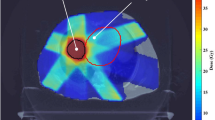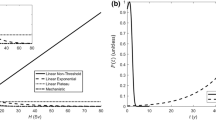Abstract
Our study is motivated by radiation therapy design for cancer treatment. We consider large-scale problems with stochastic order constraints. We establish a general result about the form of the deepest cuts associated with events of positive probability which are used in the numerical approximation of the functional constraints. An efficient method using the deepest cuts is proposed for the numerical solution of problems with second-order dominance constraints and increasing convex order constraints. We the propose a new methodology for the radiation-therapy design for cancer treatment. We introduce a risk-averse optimization problem with two types of stochastic order relations and with coherent measures of risk and consider the effect of the risk models in three versions of the problem formulation. Additionally, we propose a method that creates flexible (floating) benchmark distributions when benchmark distributions are not given apriori or when the provided distributions lead to infeasibility. We devise a numerical method using floating benchmarks for solving the proposed risk-averse optimization models for radiation therapy design. The models and methods are verified by using clinical data confirming the viability of the proposed methodology and its efficiency.




Similar content being viewed by others
Data availibility
The dataset used in the current study is not publicly available as it contains clinical data.
References
Müller, A., Stoyan, D.: Comparison Methods for Stochastic Models and Risks. Wiley, Chichester (2002)
Ogryczak, W., Ruszczyński, A.: From stochastic dominance to mean-risk models: semideviations as risk measures. Eur. J. Oper. Res. 116, 33–50 (1999)
Dentcheva, D., Ruszczyński, A.: Optimization with stochastic dominance constraints. SIAM J. Optim. 14, 548–566 (2003)
Dentcheva, D., Ruszczyński, A.: Convexification of stochastic ordering. Comptes Rendus de l’Academie Bulgare des Sciences 57, 11–16 (2004)
Dentcheva, D., Ruszczyński, A.: Semi-infinite probabilistic optimization: first order stochastic dominance constraints. Optimization 53, 583–601 (2004)
Dentcheva, D., Martinez, G.: Two-stage stochastic optimization problems with stochastic ordering constraints on the recourse. Eur. J. Oper. Res. 219, 1–8 (2012)
Lorenz, O.: Methods of measuring concentration of wealth. J. Am. Stat. Assoc. 9, 209–219 (1905)
Mann, H.B., Whitney, D.R.: On a test of whether one of two random variables is stochastically larger than the other. Ann. Math. Stat. 18, 50–60 (1947)
Gastwirth, J.L.: A general definition of the Lorenz curve. Econometrica 39, 1037–1039 (1971)
Mosler, K., Scarsini, M.: Stochastic Orders and Decision Under Risk. Institute of Mathematical Statistics, Hayward (1991)
Ogryczak, W., Ruszczyński, A.: Dual stochastic dominance and related mean risk models. SIAM J. Optim. 13, 60–78 (2002)
Greselin, F., Puri, M.L., Zitikis, R.: L-functions, processes, and statistics in measuring economic inequality and actuarial risks. Stat. Interface 2(2), 227–245 (2009)
Shapiro, A., Dentcheva, D., Ruszczyński, A.: Lectures on Stochastic Programming: Modeling and Theory (3rd. Ed.) vol. 28. SIAM, (2021)
Dentcheva, D., Ruszczyński, A.: Optimality and duality theory for stochastic optimization problems with nonlinear dominance constraints. Math. Program. 99, 329–350 (2004)
Dentcheva, D., Ruszczyński, A.: Inverse stochastic dominance constraints and rank dependent expected utility theory. Math. Program. 108, 297–311 (2006)
Dentcheva, D., Ruszczyński, A.: Duality between coherent risk measures and stochastic dominance constraints in risk-averse optimization. Pacific J. Optim. 4(3), 433–446 (2008)
Luedtke, J.: New formulations for optimization under stochastic dominance constraints. SIAM J. Optim. 19(3), 1433–1450 (2008)
Rudolf, G., Ruszczyński, A.: Optimization problems with second order stochastic dominance constraints: duality, compact formulations, and cut generation methods. SIAM J. Optim. 19, 1326–1343 (2008)
Fábián, C.I., Mitra, G., Roman, D.: Processing second-order stochastic dominance models using cutting-plane representations. Math. Program. 130, 33–57 (2011)
Dentcheva, D., Ruszczyński, A.: Inverse cutting plane methods for optimization problems with second-order stochastic dominance constraints. Optimization 59, 323–338 (2010)
Sun, H., Xu, H., Meskarian, R., Wang, Y.: Exact penalization, level function method, and modified cutting-plane method for stochastic programs with second order stochastic dominance constraints. SIAM J. Optim. 23(1), 602–631 (2013)
Dentcheva, D., Martinez, G., Wolfhagen, E.: Augmented Lagrangian methods for solving optimization problems with stochastic-order constraints. Oper. Res. 64(6), 1451–1465 (2016)
Rockafellar, R.T.: Conjugate Duality and Optimization vol. 16. SIAM, (1974)
Prékopa, A.: Stochastic Programming. Kluwer Acad. Publ, Dordrecht, Boston (1995)
Bortfeld, T., Bürkelbach, J., Boesecke, R., Schlegel, W.: Methods of image reconstruction from projections applied to conformation radiotherapy. Phys. Med. Biol. 35(10), 1423 (1990)
Holmes, T., Mackie, T.R.: A filtered backprojection dose calculation method for inverse treatment planning. Med. Phys. 21(2), 303–313 (1994)
Xing, L., Chen, G.T.: Iterative methods for inverse treatment planning. Phys. Med. Biol. 41(10), 2107 (1996)
Shepard, D.M., Olivera, G.H., Reckwerdt, P.J., Mackie, T.R.: Iterative approaches to dose optimization in tomotherapy. Phys. Med. Biol. 45(1), 69 (2000)
Webb, S.: Optimisation of conformal radiotherapy dose distribution by simulated annealing. Phys. Med. Biol. 34(10), 1349 (1989)
Mageras, G.S., Mohan, R.: Application of fast simulated annealing to optimization of conformal radiation treatments. Med. Phys. 20(3), 639–647 (1993)
Rosen, I.I., Lam, K.S., Lane, R.G., Langer, M., Morrill, S.M.: Comparison of simulated annealing algorithms for conformal therapy treatment planning. Int. J. Radiat. Oncol. Biol. Phys. 33(5), 1091–1099 (1995)
Hamacher, H.W., Küfer, K.-H.: Inverse radiation therapy planning-a multiple objective optimization approach. Discret. Appl. Math. 118(1), 145–161 (2002)
Bortfeld, T., Küfer, K.H., Monz, M., Scherrer, A., Thieke, C., Trinkhaus, H.: Intensity-modulated Radiotherapy-a Large Scale Multi-criteria Programming Problem. Fraunhofer-Institut für Techno- und Wirtschaftsmathematik, Fraunhofer (ITWM), (2003)
Bortfeld, T., Stein, J., Preiser, K.: Clinically relevant intensity modulation optimization using physical criteria. in Proceedings of XIIth International Conference on Use of Computers in Radiation Therapy, pp. 1–4 (1997)
Spirou, S.V., Chui, C.-S.: A gradient inverse planning algorithm with dose-volume constraints. Med. Phys. 25(3), 321–333 (1998)
Wu, Q., Mohan, R.: Algorithms and functionality of an intensity modulated radiotherapy optimization system. Med. Phys. 27(4), 701–711 (2000)
Oelfke, U., Bortfeld, T.: Inverse planning for photon and proton beams. Med. Dosim. 26(2), 113–124 (2001)
Langer, M., Brown, R., Urie, M., Leong, J., Stracher, M., Shapiro, J.: Large scale optimization of beam weights under dose-volume restrictions. Int. J. Rad. Oncol. Biol. Phys. 18(4), 887–893 (1990)
Lee, E.K., Fox, T., Crocker, I.: Integer programming applied to intensity-modulated radiation therapy treatment planning. Ann. Oper. Res. 119(1–4), 165–181 (2003)
Wu, Q., Mohan, R.: Multiple local minima in IMRT optimization based on dose-volume criteria. Med. Phys. 29(7), 1514–1527 (2002)
Llacer, J., Deasy, J.O., Bortfeld, T.R., Solberg, T.D., Promberger, C.: Absence of multiple local minima effects in intensity modulated optimization with dose-volume constraints. Phys. Med. Biol. 48(2), 183 (2003)
Wu, C., Jeraj, R., Mackie, T.R.: The method of intercepts in parameter space for the analysis of local minima caused by dose-volume constraints. Phys. Med. Biol. 48(11), 149 (2003)
Romeijn, H.E., Ahuja, R.K., Dempsey, J.F., Kumar, A.: A new linear programming approach to radiation therapy treatment planning problems. Oper. Res. 54(2), 201–216 (2006)
Kishimoto, S., Yamashita, M.: A successive lp approach with c-var type constraints for IMRT optimization. Oper. Res. Health Care 17, 55–64 (2018)
Unkelbach, J., Alber, M., Bangert, M., Bokrantz, R., Chan, T.C.Y., Deasy, J.O., Fredriksson, A., Gorissen, B.L., Van Herk, M., Liu, W.: Robust radiotherapy planning. Phys. Med. Biol. 63(22), 22TR02 (2018)
Acknowledgements
The authors express their gratitude to Dr. Ning J. Yue, Department of Radiation Oncology, The Rutgers University Robert–Wood–Johnson Medical School, for kindly providing us with clinical data for the experiments. We are also grateful to the three anonymous referees whose critics helped improve the paper.
Author information
Authors and Affiliations
Corresponding author
Ethics declarations
Conflict of interest
The authors have no competing interests to declare that are relevant to the content of this article.
Additional information
This paper is dedicated to Asen Dontchev, with gratitude for his mentorship and in appreciation of his fundamental contributions to the theory of optimization and control.
Publisher's Note
Springer Nature remains neutral with regard to jurisdictional claims in published maps and institutional affiliations.
Rights and permissions
Springer Nature or its licensor (e.g. a society or other partner) holds exclusive rights to this article under a publishing agreement with the author(s) or other rightsholder(s); author self-archiving of the accepted manuscript version of this article is solely governed by the terms of such publishing agreement and applicable law.
About this article
Cite this article
Vitt, C.A., Dentcheva, D., Ruszczyński, A. et al. The deepest event cuts in risk-averse optimization with application to radiation therapy design. Comput Optim Appl 86, 1347–1372 (2023). https://doi.org/10.1007/s10589-023-00531-x
Received:
Accepted:
Published:
Issue Date:
DOI: https://doi.org/10.1007/s10589-023-00531-x




